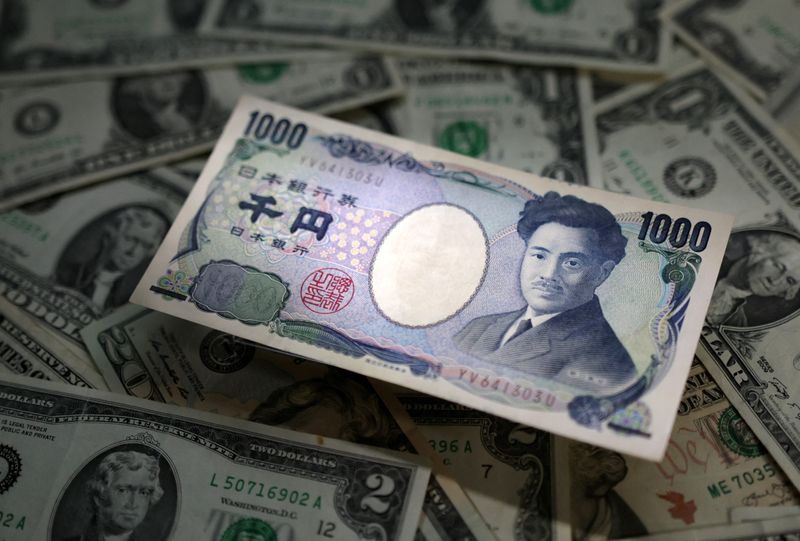Street Calls of the Week
By Samuel Indyk and Rae Wee
LONDON (Reuters) -The yen fell close to the psychological 150 per dollar level on Tuesday ahead of a key reading on U.S. inflation due later in the day, while the pound rose to an almost six-month high against the euro after stronger-than-forecast wage data.
The Swiss franc dropped to multi-week lows versus the euro and dollar after lower-than-forecast consumer prices spurred rate cut bets.
The greenback rose to an 11-week high of 149.695 yen, edging toward the closely-watched 150 level that analysts said would likely trigger further jawboning from Japanese officials in an attempt to support the currency.
The yen, which has tumbled more than 5% against the dollar year-to-date, is under persistent pressure as investors pare back their expectations of the scale and pace of the Federal Reserve's easing cycle.
Yen bears are also being emboldened by signs the Bank of Japan will resist aggressively hiking rates even if it exits negative interest rates this year as markets are wagering.
"The rate spread convergence that lifted the yen late last year is being unwound as markets recalibrate expectations in response to a surprisingly resilient U.S. economy and receding prospects of a near-term BoJ hike," said Kyle Chapman, FX markets analyst at Ballinger and co.
Sterling hit its strongest level in almost six months at 85.03 pence per euro even as British pay grew at the slowest pace in more than a year, the slowdown was less strong than most analysts had forecast and Britain's jobless rate unexpectedly fell.
The pound also rose 0.3% against the dollar to $1.2662.
"Labour data in the UK came in stronger than expected allowing GBP-USD to further rebound," said Roberto Mialich, FX strategist at UniCredit.
"A pickup in UK CPI-inflation is also expected for January, which might keep sterling further firm," he added. January inflation data is released on Wednesday.
SWISS HEADLINE INFLATION
Meanwhile, a large decrease in headline inflation in Switzerland sent the franc to multi-week lows against the dollar and euro, prompting a slew of rate cut bets as early as March.
"The numbers released today reinforce our view that the SNB will be the first G10 central bank to cut rates in this monetary policy cycle," said Capital Economics Europe economist Adrian Prettejohn, who has pencilled in a cut at next month's meeting.
The franc was down as much as 0.7% to 0.8815 per dollar, its weakest since Dec. 11, and to 0.9493 per euro, its weakest since Dec. 18.
Elsewhere, the euro was flat against the greenback at $1.0774, while the Aussie and kiwi fell both fell 0.2% against the U.S. currency.
That left the dollar index little changed at 104.13 before key inflation data later on Tuesday.
"If we see inflation remaining sticky that will drive the dollar stronger," said Amanda Sundström, fixed income and FX strategist at SEB.
"But if we get some relief here and see anything that confirms inflation is softening, that will give us a weaker dollar."
A recent run of resilient economic data in the United States, particularly a blowout jobs report this month, has heightened expectations that U.S. rates are likely to stay higher for longer.
Markets are now pricing in just about 110 basis points of rate cuts from the Fed this year beginning in May, down from about 160 bps at the end of last year.
In cryptocurrencies, bitcoin touched its highest since December 2021 at $50,383 and steadied above $50,000 for a second day running.
The world's largest cryptocurrency has risen nearly 18% this year, helped by last month's regulatory nod for U.S.-listed exchange traded funds (ETFs) designed to track its price.
